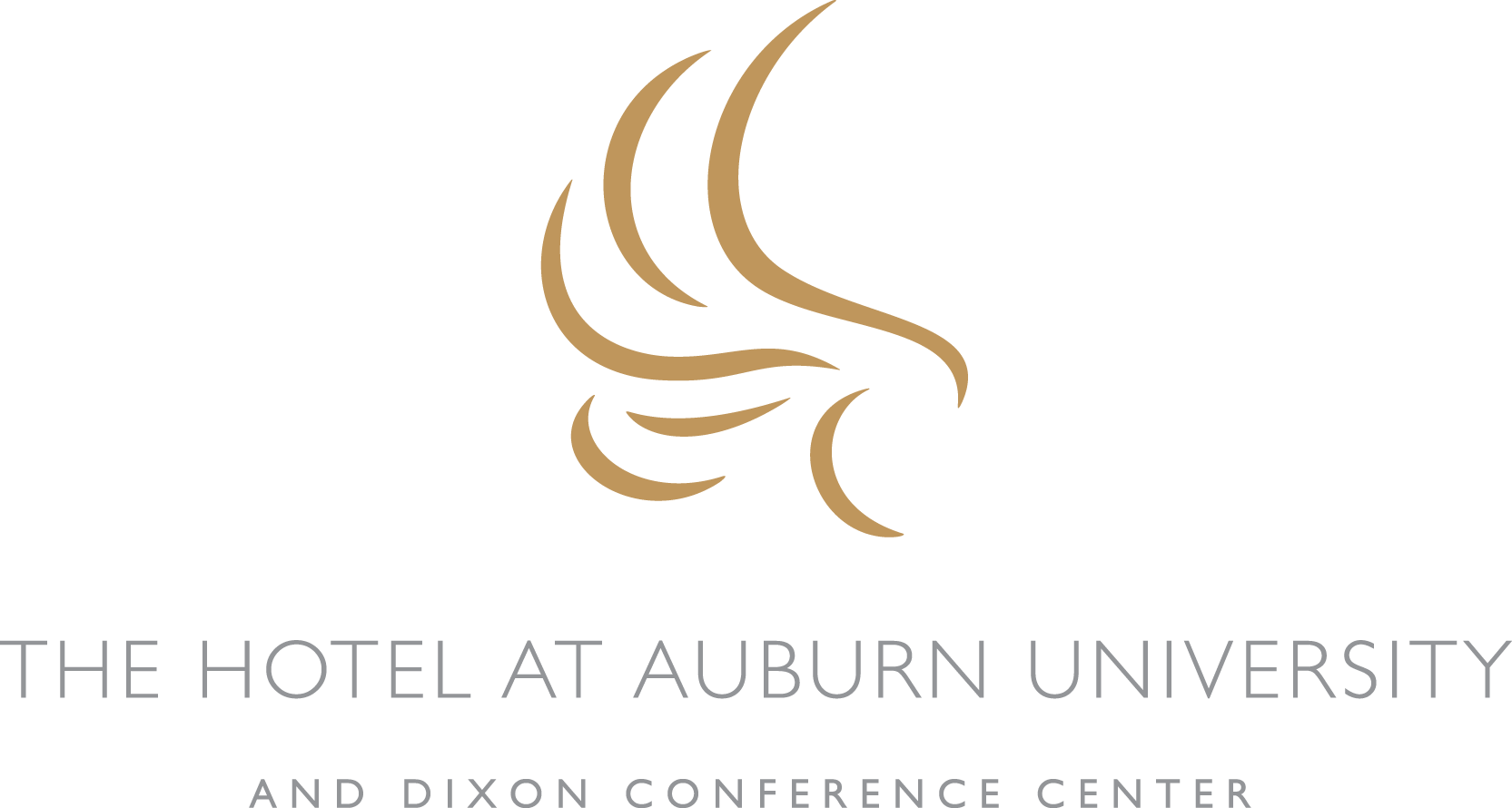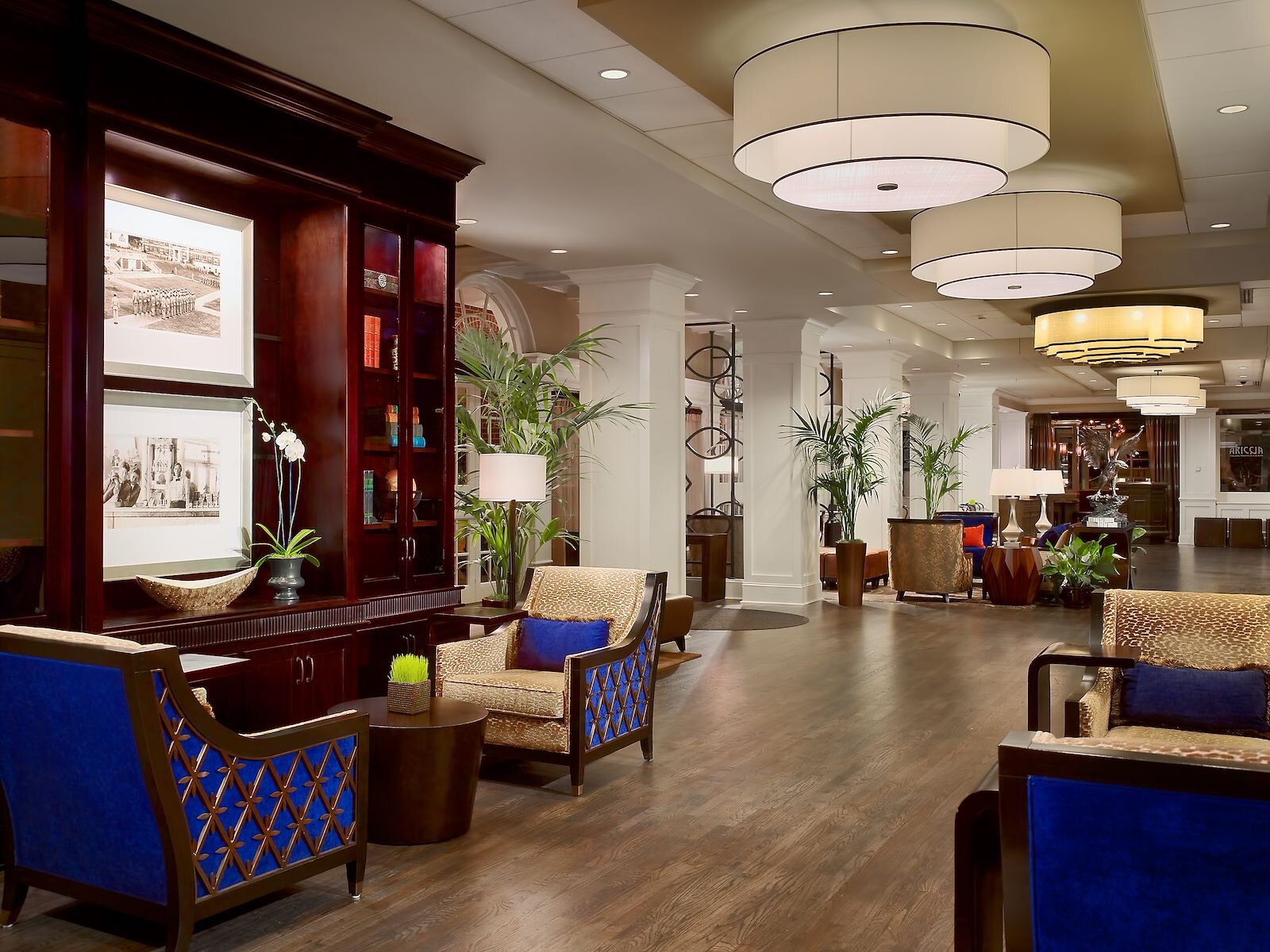The Lobby Art Tour
The photographs located in the lobby at The Hotel at Auburn University were provided by Auburn University Photographic Services. Inside our hotel at Auburn University, Davis Shelfer with Photo Services wrote the descriptions for the displayed Auburn University photography and art by compiling information from numerous sources, including visual clues and written descriptions on the images themselves, information on the envelopes containing these negatives, digital descriptions, and information from Auburn: A Pictorial History of the Loveliest Village – Revised (ISBN: 1-885860-08-0)
Auburn Train Station
API students are seen here waiting for a train to take them up to Atlanta and the ROTC summer camp at Fort McPherson in 1942. Trace your finger down from the letter "A" on the "Auburn" sign on the depot wall and you will find the smiling face of All-American halfback Monk Gafford with a dark letterman sweater bearing an "A."
The Bottle
On the far northern side of Auburn, where Highway 147 meets US 280, is a community known as "The Bottle, Alabama." It was named in honor of the Nehi Bottle, pictured here, which was erected in 1924 as "the world's largest bottle." It was bright orange, 64 feet tall, and housed a grocery store, service station, living quarters, storage, and an observation tower. President FDR visited this strange sight on his visit to Auburn, and the building stood until fire claimed it in the mid-30s.
1890s Faculty
Roughly half of the gentlemen pictured in this image have buildings named after them on campus:
Left to right, front row: Charles C. Thach, professor of English and Political Economy [later President]; General James H. Lane, professor of civil engineering and drawing; Otis D. Smith, professor of mathematics and later acting president; President William LeRoy Broun, president and professor of physics and astronomy; Patrick H. Mell, professor of botany and geology, and later second director of the Agricultural Experiment Station; Colonel Alexander Bondurant, professor of agriculture; Charles A. Cary, professor of physiology and veterinary medicine, and later dean of veterinary medicine.
Left to right, middle row: J.M. Stedman, professor of biology; John Jenkins Wilmore, professor of mechanical engineering, and later dean of engineering and mines; Charles H. Ross, professor of modern languages and English; George Petrie, head professor of history, and later dean of the academic faculty and of the graduate school.
Left to right, back row: Anthony Foster McKissick, professor of electrical engineering; Bennett Battle Ross, professor of chemistry, and later dean of agricultural sciences, chemistry and pharmacy; Colonel John H. Wills, commandant and professor of military science and tactics.
Drum Major
This photo, dated 1960 on the vague envelope containing it, shows an Auburn drum major conducting the Auburn band before a huge crowd.
Sani-Freeze
Sani-Freeze — a.k.a "the Flush" — began serving shakes, sundaes, drinks, sandwiches, and hot dogs out of this tiny building on Glenn Ave. just east of College St. in 1962. This building was previously known as the DollHouse, which served the same food in a diner setting. The Sani-Freeze building remained until 1995 when it was demolished by AmSouth and replaced with a red-brick building, despite student protests led by the Plainsman.
Samford Hall
Unfortunately there is not a date listed for this image. This picture could have been taken at any point between the early 1910s and the late 1920s.
War Eagle I
This Golden Eagle was found on a farm near Auburn trapped in pea vines, purchased for $10 by members of the Auburn community, and finally turned over to the A-Club. In this picture, two cheerleaders stand holding War Eagle I's proud wings. These cheerleaders took good care of the eagle, and it proved to be a good luck charm. Auburn won the first game War Eagle attended, beating South Carolina 25-7 on the road to snap a four-season losing streak against Southern Conference opponents.
1892 Football Team
This is the team that won one of the South's earliest "big" football games by stunning Georgia 10-0 in Atlanta. Students were not the only ones allowed on the team, as three professors are on this team. They were led by Coach Petrie (back row, far right).
1943 Troops on the Quad
Soldiers, during this year, lived in the Woman's Quadrangle as members of the Army Specialized Training Program. Female students who were displaced from the Quad were moved into fraternity houses, which were mostly empty due to the war.
1913 Toomer's Drugs
The man in the bowtie is Hugh Tamplin, and the marble counter at Toomer's was known to API cadets as "Hugh's Bar" due to the vast amounts of soda machines he tended.
City of Auburn Aerial 1930
A Maxwell Field pilot coming in from the west made this fantastic aerial shot of Auburn's campus. Samford Hall is dead center, and many famous buildings are visible in this shot, from the Alumni Gym, Cater Hall (which was the President's Home at the time), the famous water tower behind Toomer's Drugs (which Auburn students would climb to paint greek letters, football scores and, in the case of this picture, class numerals [note the '34]), and the Presbyterian Church (shortly before it was torn down and rebuilt), among others.


